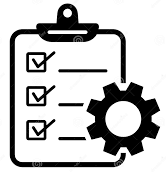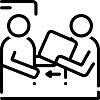Project 2: Android (using a Mobile OOP framework) + Agile Teamwork
Group Project, see projects page for group work policy and teamwork eval considerations
Due 11pm April 26 (extended from 23), Live presentations at the start of class April 30, Peer Reviews Due May 2 at 11AM.
******Peer Evaluated--how to do this******* (rubric on Canvas)
**************UNDER CONSTRUCTION ************************
-
Goals - Practice professional team-based software engineering
-
Peer Reviewed - you will be assigned to review 3 other groups' projects. You will be graded in part on doing peer reviews. Part of being a good software engineer is the ability to read other developers' code, find issues and give critique.
Points approximately --under construction ---415 points + 45 peer review (see breakdown of items and points below)
 Project Description & Requirements
Project Description & Requirements
Your team will be responsible for implementing an Android Application (ideally someone in your group will have an Android device or you will be forced to use the reduced speed/capabilities of the simulator AVD). The application must have some real functionality and have some kind of interactive interface and its purpose can NOT BE TRIVIAL. :
-
The purpose of your application can be in any sector BUT CAN NOT be trivial like a quiz or question/answer game. Your application MUST include database storage.
-
Check out the Google play store for a listing of many currently availalbe apps.
-
Check out developer.android.com which is the main entrance site for all things Android
ORIGINALITY: It is fine to look at publically available code to get ideas and to use ONLY BASIC code to get started, but, you should NOT copy code. You should also design your own GUI's. If found copying code, you will at the very least receive 0 points on this project.
NOTE: YOU NEED TO quote!!! the references you used in creating your code.!!!!!
The Process:
-
STEP 1: Create Design document + Present it
STEP 2: Get feedback and improve Design document until it is instructor approved ( this will involve needing to come to office hours)
STEP 3: Implementation - Test Driven (or at least concurrent co-development of Test Cases + running of JUnit Test Cases) -
STEP 4: Creation of Documentation As you Go- update design document, create JavaDoc for code, create videos (detailed below)
STEP 5: System Level Testing
STEP 6: Presentation
STEP7: Peer Reviews
DATA Requirements
- UNDER CONSTRUCTION ******* exploring options
Required- to use a Database in a non-trivial fashion where the data is observable by the user -
- SQLite(on device) OR Google Firebase ???
TOOLS
-
Required Tools: Git & GitHub, JUnit Test , GitHub Issues+Project+Milestone planning & Tracking, Slack/Discord, JavaDoc generative tool, GitHub Wiki&Readme , GithubPages site for JavaDoc pages.
NOTE: w/Travis Ci integration is extra credit
DETAILS - "ITEMS" (with tentative evaluation points)
|
 TeamWork
TeamWork
All members of your team will receive the same score. However, the instructor reserves the right to give different grades to team members if there are serious imbalances in the work produced.
If there are problems in your team you MUST resolve them because a key feature of this SW Engineering course is to practice Agile Teamwork and this project is the primary experience for this in this class. (see projects page for group policy)
 Extra Credit
Extra Credit
Extra Credit (30 pnts towards THIS project score only): Use either the GPS, Camera, Microphone or GyroScope and the corresponding Android API in your application ---the results should be observable by a user and NOT something trivial --it must make sense in the scope of your applications purpose (use cases) --this needs to be preapproved by the instructor to garnish extra credit.
Extra Credit (20 pnts towards THIS project score only): Use Travis CI - continuous integration and demonstrate its use by providing a document showing its use. Be prepared to show the live use.
 Deliverables:
Deliverables:
Proposal / Design Document via Exercise=your proposed Application through your Design Document that you created with your group via your OOP Design group exercise (see due date on exercise statement)which was turned in at BB->Exercises->Exercise 3 -Project 2 - Proposals . One posting per group. This is evaluated separately and not part of this project's points.
ITEM 1-7 11pm April 26 One posting for your group where you Upload URL to your GitHub OpenSource repository's wiki page WITH the list of the names of everyone in your group to the following TWO locations:
-
Canvas->Discussion Board->Project 2
Canvas->Assignments->Project 2
Peer Evaluation: due 11 AM May 2 - using the Canvas Rubric create reviews for all of the groups assigned to you.
-
******Peer Evaluated--how to do this******* (rubric on Canvas)
